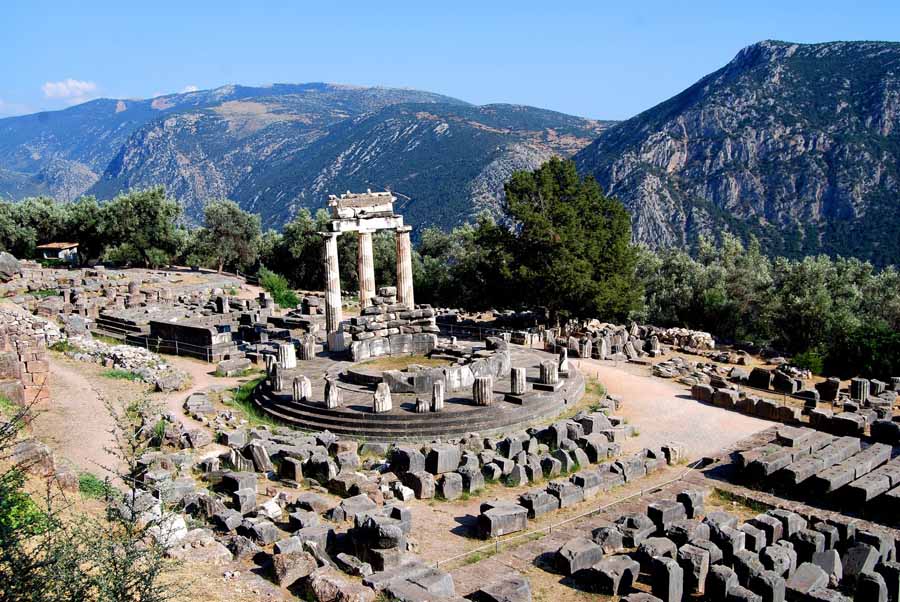

�Delphi is an archaeological site and a modern town in Greece on the south-western spur of Mount Parnassus in a valley of Phocis. Delphi was the site of the Delphic oracle, most important oracle in the classical Greek world, and it was a major site for the worship of the god Apollo. His sacred precinct in Delphi was a Panhellenic sanctuary, where every four years athletes from all over the Greek world competed in the Pythian Games.
Delphi was revered throughout the Greek world as the site of the omphalos stone, the centre of the earth and the universe. In the inner hestia ("hearth") of the Temple of Apollo, an eternal flame burned. After the battle of Plataea, the Greek cities extinguished their fires and brought new fire from the hearth of Greece, at Delphi; in the foundation stories of several Greek colonies, the founding colonists were first dedicated at Delphi.
Delphi is located on a plateau on the slope of Mount Parnassus, next to the Sanctuary of Apollo, the site of the ancient Oracle. This semicircular spur is known as Phaedriades, and overlooks the Pleistos Valley. Southwest of Delphi, about 15 km away, is the harbor-city of Kirrha on the Corinthian Gulf.
The name Delphoi is connected with delph "hollow" or delphus "womb" and may indicate archaic veneration of Gaia, Grandmother Earth, the Earth Goddess at the site. Apollo is connected with the site by his epithet Delphinios, "the Delphinian", i.e. either "the one of Delphi", or "the one of the womb". The epithet is connected with dolphins (the "womb-fish") in the Homeric Hymn to Apollo (line 400), telling how Apollo first came to Delphi in the shape of a dolphin, carrying Cretan priests on his back.
Another legend held that Apollo walked to Delphi from the north and stopped at Tempe, a city in Thessaly to pick laurel, a plant sacred to him (generally known in English as the bay tree). In commemoration of this legend, the winners at the Pythian Games received a wreath of laurel (bay leaves) picked in Tempe.
Delphi became the site of a major temple to Phoebus Apollo, as well as the Pythian Games and the famous prehistoric oracle. Even in Roman times hundreds of votive statues remained, described by Pliny the Younger and seen by Pausanias.
From a late myth that deviates from much older ones, when young, Apollo killed the chthonic serpent Python, named Pythia in older myths, but according to some later accounts his wife, Pythia, who lived beside the Castalian Spring, according to some because Python had attempted to rape Leto while she was pregnant with Apollo and Artemis. The bodies of the pair were draped around his Rod, which, with the wings created the caduceus symbolic of the god. This spring flowed toward the temple but disappeared beneath, creating a cleft which emitted vapors that caused the Oracle at Delphi to give her prophecies.
Apollo killed Python but had to be punished for it, since she was a child of Gaia. The shrine dedicated to Apollo was originally dedicated to Gaia and then, possibly to Poseidon. The name Pythia remained as the title of the Delphic Oracle. As punishment for this murder Apollo was sent to serve in menial tasks for eight years. A festival, the Septeria, was performed annually portraying the slaying of the serpent, the flight, the atonment and the return of the God. The Pythian Games took place every four years to commemorate his victory.
Erwin Rohde wrote that the Python was an earth spirit, who was conquered by Apollo, and buried under the Omphalos, and that it is a case of one deity setting up a temple on the grave of another.
Another view holds that Apollo was a fairly recent addition to the Greek pantheon coming originally from Lydia. The Etruscans coming from northern Anatolia also worshiped Apollo, and it may be that he was originally identical with Mesopotamian Aplu, an Akkadian title meaning "son", originally given to the plague God Nergal, son of Enlil. Apollo Smintheus the mouse killer eliminates mice, a primary cause of disease, hence he promotes preventive medicine. It is a popular misconception that the oracle predicted the future, based on the lapping water and leaves rustling in the trees; the oracle of Delphi never predicted the future, but gave guarded advice on how impiety might be cleansed and incumbent disaster avoided.
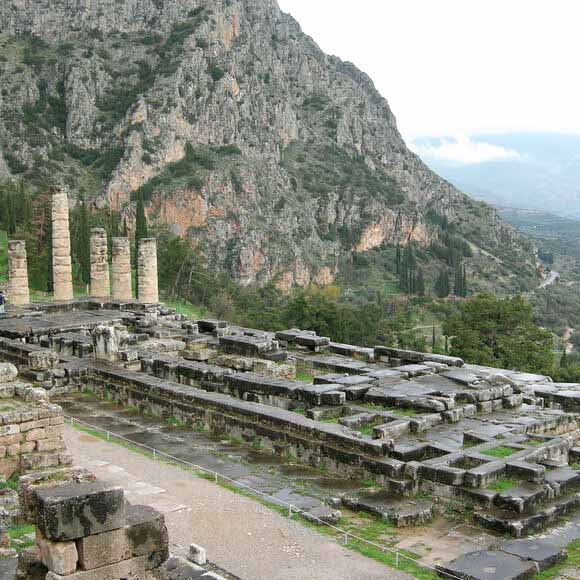
Delphi is perhaps best-known for the oracle at the sanctuary that became dedicated to Apollo during the classical period. With origins in prehistoric times and the worship of Gaia, in the last quarter of the 8th century BC there is a steady increase of artifacts found at the settlement site in Delphi. Pottery and bronze work as well as tripod dedications continue in a steady stream, in comparison to Olympia.
Neither the range of objects nor the presence of prestigious dedications proves that Delphi was a focus of attention for worshipers of a wide range, but the strong representation of high value goods, found in no other mainland sanctuary, certainly encourages that view.
The priestess of the oracle at Delphi was known as the Pythia. H.W. Parke writes that the foundation of Delphi and its oracle took place before the times of recorded history and its origins are obscure, but dating to the worship of the Great Goddess, Gaia.
The Oracle exerted considerable influence throughout the Greek world, and she was consulted before all major undertakings: wars, the founding of colonies, and so forth. She also was respected by the semi-Hellenic countries around the Greek world, such as Lydia, Caria, and even Egypt.
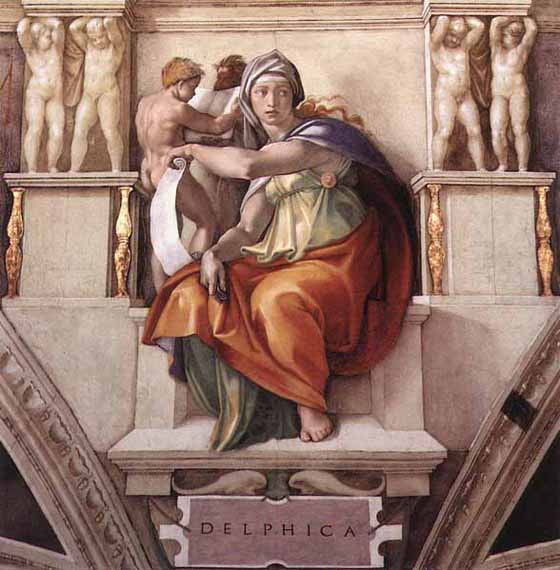
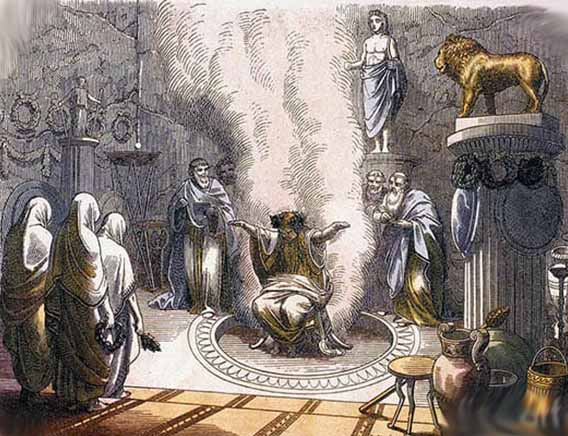
Sibyl
The Delphic Sibyl was a legendary prophetic figure who was said to have given prophecies at Delphi shortly after the Trojan War. The prophecies attributed to her circulated in written collections of prophetic sayings, along with the oracles of figures such as Bakis. The Sibyl had no connection to the oracle of Apollo, and should not be confused with the Pythia.
�The first oracle at Delphi was commonly known as Sibyl, though her name was Herophile. She sang her predictions, which she received from Gaia. Later, "Sibyl" became a title given to whichever priestess manned the oracle at the time. The Sibyl sat on the Sibylline Rock, breathing in vapors from the ground1 and gaining her often puzzling predictions from that. Pausanias claimed that the Sibyl was "born between man and goddess, daughter of sea monsters and an immortal nymph". Others said she was sister or daughter to Apollo. Still others claimed the Sibyl received her powers from Gaia originally, who passed the oracle to Themis, who passed it to Phoebe.
�The Delphic Sibyl was the priestess presiding over the Apollonian Oracle at Delphi, a Greek colony, located in a plateau on the side of Mount Parnassus. She lived on Mount Parnassus and was believed by many to be a prophet. The word sibyl comes (via Latin) from the ancient Greek word (sibulla), meaning "prophetess". There were many Sibyls in the ancient world, but the Delphic Sibyl was among the most renowned because of the famous receivers of her advice, who were said to be Aegeus, Cadmus, Herakles, Oedipus, Orestes, Perseus and Xuthus.
Two places claimed to be the birthplace of this Sibyl, who is traditionally known as the third Sibyl, namely Marpessus in the Troad and Erythrse. There are various names for the Sibyl: Pythia, Herophile and Delphica. Pausanias claimed that the Sybil was "born between man and goddess, daughter of sea monsters and an immortal nymph". Others said she was sister or daughter to Apollo. Still others claimed the Sybil received her powers from Gaia originally, who passed the oracle to Thetis, who passed it to Phoebe.
According to legend, the Sibyl was visited by Herakles after he slew his wife and children in a fit induced by Hera. The Oracle told him as penance he was required to carry out twelve tasks set by his arch-enemy, Eurystheus, who had become King in his stead.
According to legend, the Sibyl came from the Troad to Delphi before the Trojan War, "in wrath with her brother Apollo", lingered for a time at Samos, visited Claros and Delos, and died in the Troad, after surviving nine generations of men. After her death, it was said that she became a wandering voice that still brought to the ears of men tidings of the future wrapped in dark enigmas.
There have been occasional attempts to find a scientific explanation for the Sibyl's behavior. Most commonly, these refer to Plutarch's observation that the Pythia's oracular powers appeared to be linked to vapors from the Castalian Spring that surrounded her, together with the observation that sessions of prophesy would either take place in, or be preceded by a visit to, an enclosed chamber at the base of the temple. It has been suggested that these vapors may have been hallucinogenic gases. In 2001 evidence of the presence of ethylene, a potential hallucinogen, was found in the temple's local geology and nearby springs. Inhalation of ethylene in an enclosed space might well have exposed the Sibyl to sufficiently high concentrations of the narcotic gas to induce a euphoric or trance-like state.
This oracle exerted considerable influence across the country, and was consulted before all major undertakings: wars, the founding of colonies, and so forth. She also was respected by the semi-Hellenic countries around the Greek world, such as Lydia, Caria, and even Egypt. Croesus of Lydia consulted Delphi before attacking Persia, and according to Herodotus received the answer "if you do, you will destroy a great empire." Croesus found the response favorable and attacked, and was utterly overthrown (resulting, of course, in the destruction of his own empire).
The oracle is also said to have proclaimed Socrates the wisest man in Greece, to which Socrates said that if so, this was because he alone was aware of his own ignorance. This claim is related to one of the most famous mottos of Delphi, which Socrates said he learned there, Gnothi Seauton: "know thyself".
Another famous motto of Delphi is Meden Agan: "nothing in excess".
In the 3rd century A.D., the oracle (perhaps bribed) declared that the god would no longer speak there.The temple to Apollo at Delphi was built by Trophonius and Agamedes.
After investigating the site, archeologists were convinced that these vapors are only a myth, as no evidence for them could be found, and - so the then standard opinion in geology - gaseous emissions from rock only occur in conjunction with volcanic activity. However, recent geological research indicates that the site of the oracle shows young geological faults, and it seems plausible that these emitted in ancient times light hydrocarbon gases from bituminous limestone which do have an intoxicating effect. (de Boer et al., Geology 29 (2001) pp. 707; see e.g. here for a popular science coverage) Other archaeologists believe that the oracle also inhaled fumes of burning bay leaves.
The power of the Delphic oracle fluctuated and eventually lost favor as Christianity became the dominant religion of the land, said De Boer. Moreover, ancient legend suggests that the concentration of the vapors became weaker - possibly because the absence of a major earthquake failed to keep Earth's narcotic juices flowing.
Today, the water that helped transport the gases to the Delphic temple is tapped and siphoned above the temple to supply the modern town of Delphi.The work by De Boer and his colleagues is an example of modern science helping archaeologists understand how ancient peoples lived.
Another example among the ancient Greeks is the belief in Poseidon as the god of the sea and earthquakes. According to Harris-Cline, modern science associates the two with tectonic movement deep under the sea. "Our scientific techniques are just beginning to detect the natural phenomena which the Greeks celebrated and appreciated 2,500 years ago with ritual activities at these special places," she said.
From the entrance of the site, continuing up the slope almost to the temple itself, is a large number of votive statues, and numerous treasuries. These were built by the various states - those overseas as well as those on the mainland - to commemorate victories and to thank the oracle for advice important to those victories. The most impressive is the now-restored Treasury of Athens, built to commemorate the Athenians' victory at the Battle of Marathon. The Athenians had previously been given the advice by the oracle to put their faith in their "wooden walls" - taking this advice to mean their navy, they won a famous battle at Salamis. Another impressive treasury that exists on the site was dedicated by the city of Siphnos, who had ammassed great wealth from their silver and gold mines and so they dedicated the Siphnian Treasury.
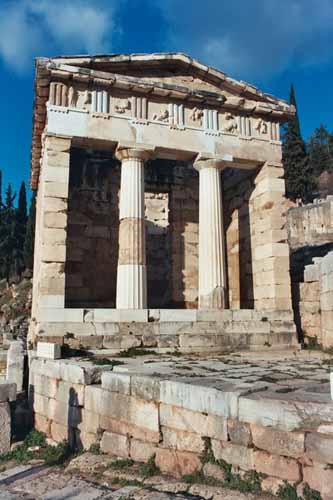
their victory at the Battle of Marathon
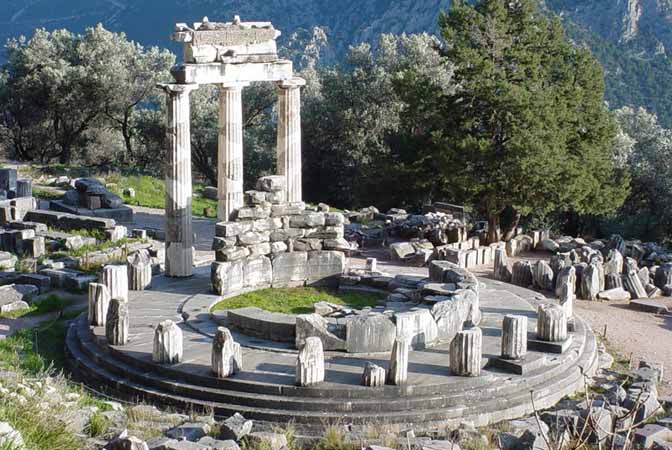
The Tholos at the sanctuary of Athena Pronaia is a circular building that was constructed between 380 and 360 B.C. It consisted of 20 Doric columns arranged with an exterior diameter of 14.76 meters, with 10 Corinthian columns in the interior. The Tholos is located approximately a half-mile (800 m) from the main ruins at Delphi. Three of the Doric columns have been restored, making it the most popular site at Delphi for tourists to take photographs.
Apollo is connected with the site by his epithet 'Delphinios', 'the Delphinian', i.e. either "the one of Delphi", or "the one of the womb".
The epithet is connected with dolphins (the "womb-fish") in the Homeric Hymn to Apollo, telling how Apollo first came to Delphi in the shape of a dolphin, carrying Cretan priests on his back.
Greek legend recounts how Apollo chose Delphi as one of his chief places of worship, along with Delos. Greek mythology tells of a time when the gods of the sky overcame those of earth. Then the infant Apollo took control of Parnassus by killing Python, the dragon snake that had possessed it. Apollo took the form of a dolphin and swam out to sea to capture a group of sailors, whom he appointed the first priests of his cult.
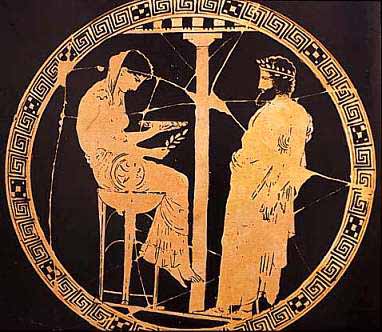
Pythia sitting on the Delphic Tripod - Cauldron and a priest
Apollo spoke through his oracle, who had to be an older woman of blameless life chosen from among the peasants of the area. The sybyl or prophetess took the name Pythia and sat on a tripod seat over an opening in the Earth. When Apollo slew Python, its body fell into this fissure, according to legend, and fumes arose from its decomposing body. Intoxicated by the vapors, the sibyl would fall into trance, allowing Apollo to possess her spirit. In this state she prophesied. She spoke in riddles, which were interpreted by the priests of the temple, and people consulted her on everything from important matters of public policy to personal affairs.
Upon arriving at Delphi, the supplicants registered and paid a fee; when their appointments neared, they purified themselves at the Castalian Spring, where the bathing trough is still visible. They then proceeded along the Sacred Way, a zigzag flagstone walk up the hill. The Sacred Way was lined with statues and offerings, most of which have long disappeared, although a few surviving examples can be seen in the Delphi Museum. Also along the way were a series of treasuries, small shrines sponsored by various Greek cities as thank-offerings for important victories. The best perserved of these is the Athenian treasury, built in 490 BC to celebrate the Athenian victory at the Battle of Marathon. Because of its balance, harmony, and purity of line, it is regarded as the finest example of ancient Doric style.
The Sacred Way ended outside the temple. There the pilgrims would sacrifice a sheep or goat, whose entrails were examined by the priests for omens. Then the pilgrims entered one by one to ask the sibyl their question. A carved domed rock, the omphalos, or naval of the earth, was kept at the place of prophecy. In an ancient flood story about the human race, the omphalos was the first thing to emerge from the waters as they receeded. In another account, Zeus sent two ravens out from from the ends of the earth to find its center, and their beaks touched at the omphalos. The stone is presently kept in a museum.
The centerpiece of Delphi was the temple of Apollo, built with donations from every Greek city-state and from abroad. The base of the temple still stands, with half a dozen of the original columns. On the outside of the base are over 700 inscriptions, most announcing the emancipation of slaves, which was considered a special act of piety to be performed at Delphi. At the far end of the temple is the altar, originally decorated with memorials, ex-votos, statues, and offerings.
The myths said that during winter, when Apollo went to his other shrine at Delos, the slopes of Mount Parnassus became the playground of the god Pan, patron of fertility. Above and away from the shrine of Delphi is a grove that is difficult to reach, at the end of an ancient cobblestone trail called the Kalki Skala, or "evil stairway." Nearby are two pinnacles from which those convicted of sacrilege against the gods were thrown to their deaths. Also in the area is the Corycian Cave, sacred to Pan, and here each November ancient worship rituals involved drinking and sexual orgies took place. The contrast with the Delphic shrine is striking, and perhaps out of embarrassment, no attempt has been made either to publicize the place or to make it easy to visit. Pan's image in art -- half-man, half goat with horns -- was adopted in the Christian era as the image of the Devil.
Above the Temple of Apollo is an outdoor theater with 33 tiers of stone seats that held about 5,000 people. A stadium seating 7,000 nearby was used for the Phythian Games, held every four years to celebrate the victory of Athens over the Phoenicians, who had attacked Delphi and tried to seize its treasures. Several centuries later, when Rome conquered Greece and Athenian protection collapsed, the Emperor Nero looted 500 statues from the shrine. In the fourth century AD, Julian the Apostate, a Christian emperor who returned to paganism, ordered Delphi's restoration as part of his campaign to restore the ancient gods, but in a eerie scene, the oracle wailed but refused to prophesy. That event was considered a sign of the end, and by 390 AD the shrine was closed by the Christian Emperor Theodosis. Soon after the temple was razed.
Delphi was the site of a major temple to Phoebus Apollo, as well as the Pythian Games and a famous oracle. Even in Roman times hundreds of votive statues remained, described by Pliny the Younger and seen by Pausanias.
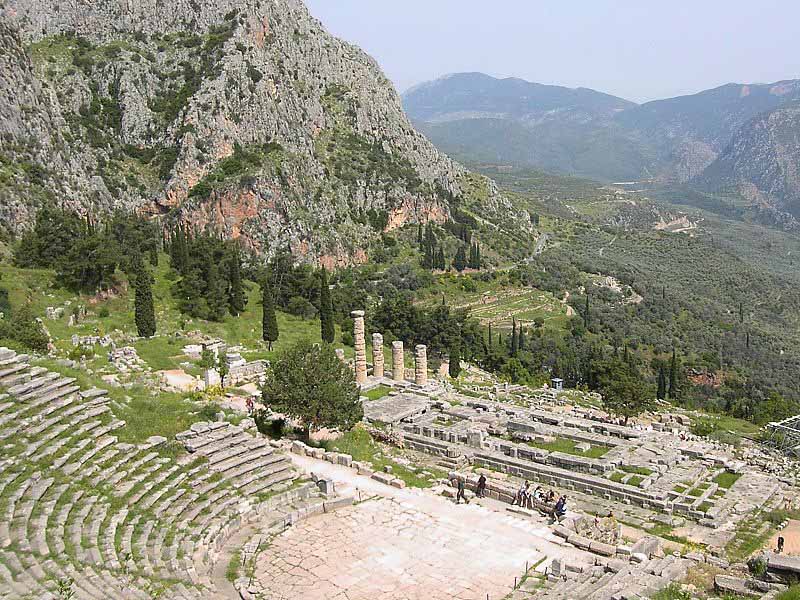
Theatre and Temple of Apollo in mountainous country at Delphi
The theater is quite well-preserved, dating to the 4th century B.C. Eumenes II of Pergamon restored it in the 2nd century, as did the Romans later. It was used for musical and theatrical portions of the Pythian Games and for meetings of Delphian citizens. Thirty-five rows provided seats for 5000 spectators as well as an excellent view overlooking the Temple of Apollo.
The Pythian Games were one of the four Panhellenic Games of Ancient Greece, a forerunner of the modern Olympic Games, held every four years at the sanctuary of Apollo at Delphi. They were held in honor of Apollo two years after (and two years before) each Olympic Games, and between each Nemean and Isthmian Games. They were founded sometime in the 6th century BC, and, unlike the Olympic Games, also featured competitions for music and poetry. The music and poetry competitions pre-dated the athletic portion of the games, and were said to have been started by Apollo after he killed Python and set up the oracle at Delphi. Otherwise, the athletic events were the same as the Olympic Games. A four-horse chariot race was held in a hippodrome in the plain, not far from the sea, in the place where the original stadium was. The winners received a wreath of bay laurels from the city of Tempe in Thessaly.
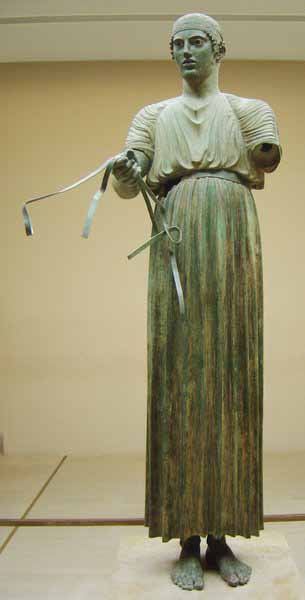
The Pythian Games comprised a chariot race,
thus this magnificent statue.
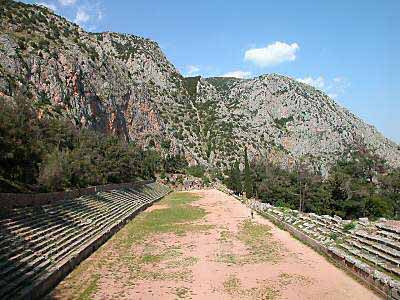
The Delphi stadium was located at the highest part of the city, partially cut into the rock. It originally sat down on the Delphian plain but was moved to this position in the 2nd and 3rd centuries A.D. The track was 600 Roman feet long and could hold 17 or 18 runners. Starting in 591 B.C., the athletic portions of the Pythian Games were held here every eight years, commemorating Apollo's slaying of the serpent Python. The stadium could seat about 6500 spectators.
When young, Apollo killed the chthonic serpent Python, which lived beside the Castalian Spring, according to some because Python had attempted to rape Leto while she was pregnant with Apollo and Artemis. This was the spring which emitted vapors that caused the Oracle at Delphi to give her prophesies. Apollo killed Python but had to be punished for it, since Python was a child of Gaia. The shrine dedicated to Apollo was probably originally dedicated to Gaia and then Poseidon. The oracle at that time predicted the future based on the lapping water and leaves rustling in the trees.
Occupation of the site at Delphi can be traced back to the Neolithic period with extensive occupation and use beginning in the Mycenaean period (1600-1100 B.C). Most of the ruins that survive today date from the most intense period of activity at the site in the 6th century BCE.
In the inner (hestia), or hearth, of the Temple of Delphic Apollo (Apollon Delphinios), an (eternal flame) burned. After the battle of Plataea, the Greek cities extinguished their fires and brought new fire from the hearth of Greece, at Delphi; in the foundation stories of several Greek colonies, the founding colonists were first dedicated at Delphi.
The Marmaria was the Sanctuary of Athena, who was considered to be the guardian of the temple. It included several structures, including the temple of Athena Pronoia and the temple of Athena Ergane. This tholos, or rotunda, was built in the early 4th century B.C. by the architect Theodoros. Twenty Doric columns surrounded a three-stepped platform. These three columns, reconstructed in 1938, show what the tholos would have looked like when it was still standing.
The modern Delphi or Delfi or Delfoi is situated west of the archaeological site. It is passed by a major highway linking Amfissa along with Itea and Arachova. The main street is two-ways. Delphi also has a school, a lyceum and a square (plateia). The communities include Chrysso which in ancient times was Crissa. Read more ...